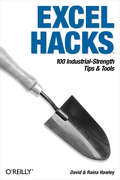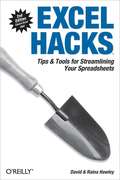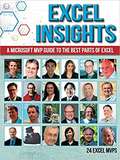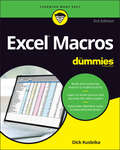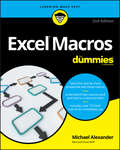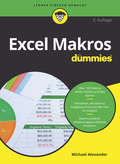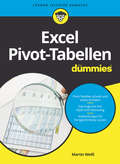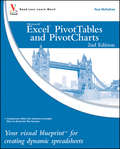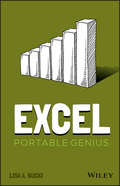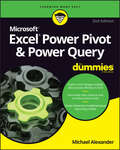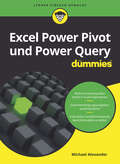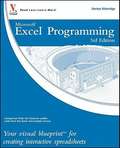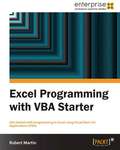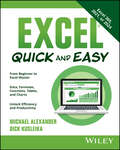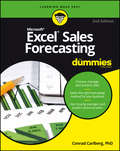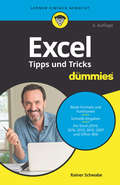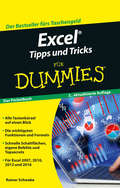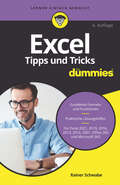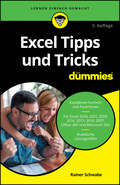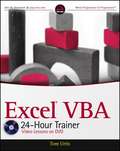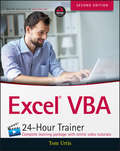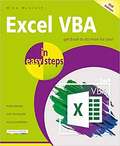- Table View
- List View
Excel Hacks, 2nd Edition
by David Hawley Raina HawleyMillions of users create and share Excel spreadsheets every day, but few go deeply enough to learn the techniques that will make their work much easier. There are many ways to take advantage of Excel's advanced capabilities without spending hours on advanced study. Excel Hacks provides more than 130 hacks -- clever tools, tips and techniques -- that will leapfrog your work beyond the ordinary. Now expanded to include Excel 2007, this resourceful, roll-up-your-sleeves guide gives you little known "backdoor" tricks for several Excel versions using different platforms and external applications. Think of this book as a toolbox. When a need arises or a problem occurs, you can simply use the right tool for the job. Hacks are grouped into chapters so you can find what you need quickly, including ways to: * Reduce workbook and worksheet frustration -- manage how users interact with worksheets, find and highlight information, and deal with debris and corruption. * Analyze and manage data -- extend and automate these features, moving beyond the limited tasks they were designed to perform. * Hack names -- learn not only how to name cells and ranges, but also how to create names that adapt to the data in your spreadsheet. * Get the most out of PivotTables -- avoid the problems that make them frustrating and learn how to extend them. * Create customized charts -- tweak and combine Excel's built-in charting capabilities. * Hack formulas and functions -- subjects range from moving formulas around to dealing with datatype issues to improving recalculation time. * Make the most of macros -- including ways to manage them and use them to extend other features. * Use the enhanced capabilities of Microsoft Office 2007 to combine Excel with Word, Access, and Outlook. You can either browse through the book or read it from cover to cover, studying the procedures and scripts to learn more about Excel. However you use it, Excel Hacks will help you increase productivity and give you hours of "hacking" enjoyment along the way.
Excel Hacks: 100 Industrial Strength Tips and Tools
by David Hawley Raina HawleyIf you think that getting creative with Excel means the underhanded tweaking of numbers, think again. Excel Hacks shows even the most experienced users how to do things with Excel they might never have thought of doing--and lets them have a little fun while they're at it.Microsoft Excel is not just the dominant spreadsheet in the world; it's also one of the most popular applications ever created. Its success lies not only in its power and flexibility, but also in its streamlined, familiar interface that casually conceals its considerable capabilities. You don't need to know everything that Excel can do in order to use it effectively, but if you're like the millions of Excel power users looking to improve productivity, then Excel Hacks will show you a wide variety of Excel tasks you can put to use, most of which are off the beaten path.With this book, Excel power users can bring a hacker's creative approach to both common and uncommon Excel topics--"hackers" in this sense being those who like to tinker with technology to improve it. The "100 Industrial Strength Tips and Tools" in Excel Hacks include little known "backdoor" adjustments for everything from reducing workbook and worksheet frustration to hacking built-in features such as pivot tables, charts, formulas and functions, and even the macro language.This resourceful roll-up-your-sleeves guide is for intermediate to advanced Excel users eager to explore new ways to make Excel do things--from data analysis to worksheet management to import/export--that you never thought possible. Excel Hacks will help you increase productivity with Excel and give you hours of "hacking" enjoyment along the way.
Excel Hacks: Tips & Tools for Streamlining Your Spreadsheets
by David Hawley Raina HawleyMillions of users create and share Excel spreadsheets every day, but few go deeply enough to learn the techniques that will make their work much easier. There are many ways to take advantage of Excel's advanced capabilities without spending hours on advanced study. Excel Hacks provides more than 130 hacks -- clever tools, tips and techniques -- that will leapfrog your work beyond the ordinary.Now expanded to include Excel 2007, this resourceful, roll-up-your-sleeves guide gives you little known "backdoor" tricks for several Excel versions using different platforms and external applications. Think of this book as a toolbox. When a need arises or a problem occurs, you can simply use the right tool for the job. Hacks are grouped into chapters so you can find what you need quickly, including ways to:Reduce workbook and worksheet frustration -- manage how users interact with worksheets, find and highlight information, and deal with debris and corruption.Analyze and manage data -- extend and automate these features, moving beyond the limited tasks they were designed to perform.Hack names -- learn not only how to name cells and ranges, but also how to create names that adapt to the data in your spreadsheet.Get the most out of PivotTables -- avoid the problems that make them frustrating and learn how to extend them.Create customized charts -- tweak and combine Excel's built-in charting capabilities.Hack formulas and functions -- subjects range from moving formulas around to dealing with datatype issues to improving recalculation time.Make the most of macros -- including ways to manage them and use them to extend other features.Use the enhanced capabilities of Microsoft Office 2007 to combine Excel with Word, Access, and Outlook.You can either browse through the book or read it from cover to cover, studying the procedures and scripts to learn more about Excel. However you use it, Excel Hacks will help you increase productivity and give you hours of "hacking" enjoyment along the way.
Excel Insights: A Microsoft MVP Guide To The Best Parts Of Excel
by 24 Excel MVPsLearn favorite techniques from this group of twenty-two Excel MVPs. The Excel MVPs are friends and competitors who each pulled out their favorite tricks to impress you and their fellow MVPs.
Excel Macros For Dummies
by Dick KusleikaSave time and become an Excel wizard with the world’s leading Excel macro guide Do you love Excel and all the things you can do with it, but wish you could just work…faster? Excel macros—automated workflows that save you time and energy—might be just what you need. In Excel Macros For Dummies, you’ll learn over 70 of the most productive, time-saving macros in less time than it takes to back up the files on your computer! Every chapter in the book gives you practical info and exercises you can put to work immediately, alongside step-by-step instructions and guidance on how to customize Excel to fit your every need. Inside, you’ll find: Automations that take your Excel productivity to the next level, and beyond Fully updated macros compatible with the newest version of Excel included in Microsoft 365 Careful explanations of the basics as well as tips for the advanced user With something for everyone, Excel Macros For Dummies is the productivity supercharger you’ve been waiting for. Grab a copy today!
Excel Macros For Dummies
by Michael AlexanderReady-made Excel macros that will streamline your workflow Excel Macros For Dummies helps you save time, automate, and be more productive, even with no programming experience at all. Each chapter offers practical macros that you can implement right away, with practical exercises that extend your knowledge and help you understand the mechanics at work. You'll find the most effective Excel macros for solving common problems, and explanations of why and where to use each one, plus invaluable guidance and step-by-step instruction for applying them effectively. Learn how to customize your applications to look and work exactly the way you want them to, with simple, friendly walk-throughs that directly apply to real-world tasks. Follow it through from start to finish, or quickly look up problems as they occur; the book's clear layout and organization makes it an irreplaceable desk reference, and all macro code is available for download from the companion website. Microsoft Excel is the world's leading spreadsheet application, and it supports VBA macros that allow you to customize the program and automate many common tasks. This book helps you take advantage of macros to get more done, and get it done better. Grasp the fundamentals of VBA and macros Work with workbooks, worksheets, and ranges Clean data, automate reporting, and send email from Excel Use tips and tricks that streamline your workflow If you have an Excel problem, there's a macro to solve it. You don't need to be a programmer, and you don't need to spend months learning code. Excel Macros For Dummies gives you the "recipes" you need, and the knowledge to apply them effectively.
Excel Makros für Dummies (Für Dummies)
by Michael AlexanderExcel-Makros sind ein Mysterium für Sie? Sie haben das Ziel, selbst Makros zu schreiben? Oder wollen wissen, wie Sie mit Excel Makros wertvolle Zeit sparen können? In dieser aktualisierten Auflage hat Michael Alexander die 70 gebräuchlichsten Excel-Makro-Anwendungen für Sie zusammengestellt. Er beginnt mit einer knappen Einführung in die Makrogrundlagen und VBA, erläutert aber auch, wie Sie Makros anwenden, an Ihre Bedürfnisse anpassen und sie selbst schreiben. So lernen Sie Makros effizient einsetzen und das Fehlerpotenzial manueller Eingaben reduzieren.
Excel Pivot-Tabellen für Dummies (Für Dummies)
by Martin WeissPivot-Tabellen haben völlig zu Unrecht den Ruf, kompliziert und nur etwas für Excel-Profis zu sein. Wenn die Daten, die Sie auswerten wollen, in großen Excel-Tabellen vorliegen, sind auch für Sie Pivot-Tabellen ein unverzichtbares Werkzeug. Pivot-Tabellen ermöglichen Ihnen, Daten nach verschiedenen Kriterien auszuwählen, zusammenzufassen und zueinander in Beziehung zu setzen. Plötzlich wird in der Flut der Daten ein System erkennbar, Zusammenhänge werden sichtbar. Wie Sie aus üblichen Excel-Tabellen mit wenigen Mausklicks Pivot-Tabellen machen und worauf Sie bei den Quelldaten und bei der Formatierung achten sollten, erfahren Sie in diesem Buch. Fortgeschrittene Nutzer werden sich über die Einführung in Power Pivot und Power Query und die Themen Datenschnitte, Zeitachsen und berechnete Felder und Elemente freuen.
Excel Pivot-Tabellen für Dummies (Für Dummies)
by Martin WeissPivot-Tabellen haben völlig zu Unrecht den Ruf, kompliziert und nur etwas für Excel-Profis zu sein. Wenn die Daten, die Sie auswerten wollen, in großen Excel-Tabellen vorliegen, sind auch für Sie Pivot-Tabellen und Pivot-Charts ein unverzichtbares Werkzeug. Pivot-Tabellen und -Charts ermöglichen Ihnen, Daten nach verschiedenen Kriterien auszuwählen, zusammenzufassen und zueinander in Beziehung zu setzen. Plötzlich wird in der Flut der Daten ein System erkennbar, Zusammenhänge werden sichtbar. Wie Sie aus üblichen Excel-Tabellen mit wenigen Mausklicks Pivot-Tabellen machen und worauf Sie bei den Quelldaten und bei der Formatierung achten sollten, erfahren Sie in diesem Buch. Fortgeschrittene Nutzer werden sich über die Themen Datenschnitte, Zeitachsen und berechnete Felder und Elemente freuen.
Excel PivotTables and PivotCharts: Your visual blueprint for creating dynamic spreadsheets (Visual Blueprint #40)
by Paul McFedriesMaster two of the most powerful features of Excel Even if you use Excel all the time, you may not be up to speed on two of Excel's most useful features. PivotTable and PivotChart turn long lists of unreadable data into dynamic, easy-to-read tables and charts that highlight the information you need most; you can tweak results with a click or easily fuse data from several sources into one document. Now you can learn how to tap these powerful Excel tools with this practical guide. Using a series of step-by-step tutorials and easy-to-follow screenshots, this book shows you in a visual way how to create and customize PivotTables and PivotCharts, use them to analyze business data, and ultimately achieve more with less work. Explains the benefits PivotTables and PivotCharts, two powerful features of Excel that allow users to create dynamic spreadsheets Covers creating and customizing, analyzing business data, building custom calculations, linking to external data sources (including Access databases, Word tables, Web pages, XML data, SQL Server databases, and OLAP cubes), creating macros to automate tasks, and more Uses step-by-step tutorials and easy-to-follow screenshots, a "learn by seeing" approach for visual learners Practical, visual, and packed with content, this is the book you need to ramp up your Excel skills with PivotTables and PivotCharts.
Excel Portable Genius: Power Toolkit (Portable Genius)
by Lisa A. BuckiYour genius-level guide to Excel excellence Excel Portable Genius covers the key features of Microsoft Excel in a concise, fast-paced, portable format that provides the perfect quick and easy-to-follow reference for novices and experienced users alike. Written by seasoned tech expert and trainer Lisa A. Bucki, it answers the nine key questions Excel users are most likely to face in their work and adds some hot tips and advice on this incredibly useful—but sometimes difficult-to-learn—program’s lesser-known features. Build formulas to perform powerful calculations Format data to make it easy to find interpret and to highlight key results Sort and filter to organize or display specific information Chart data to pinpoint changes and identify trends Communicate results by printing and sharing Complete with a comprehensive index and extensive illustrations complementing straightforward instructions, this is the ideal guide to mastery of the world’s most popular spreadsheet program.
Excel Power Pivot & Power Query For Dummies
by Michael AlexanderLearn to crunch huge amounts of data with PowerPivot and Power Query Do you have a ton of data you need to make sense of? Microsoft’s Excel program can handle amazingly large data sets, but you’ll need to get familiar with PowerPivot and Power Query to get started. And that’s where Dummies comes in. With step-by-step instructions—accompanied by ample screenshots—Excel PowerPivot & Power Query For Dummies will teach you how to save time, simplify your processes, and enhance your data analysis and reporting. Use Power Query to discover, connect to, and import your organization’s data. Then use PowerPivot to model it in Excel. You’ll also learn to: Make use of databases to store large amounts of data Use custom functions to extend and enhance Power Query Add the functionality of formulas to PowerPivot and publish data to SharePoint If you’re expected to wrangle, interpret, and report on large amounts of data, Excel PowerPivot & Power Query For Dummies gives you the tools you need to get up to speed quickly.
Excel Power Pivot und Power Query für Dummies (Für Dummies)
by Michael AlexanderHaben Sie eine große Menge an Daten, die Sie sinnvoll verarbeiten müssen? Dabei helfen Ihnen Excel Power Pivot und Power Query. In diesem Buch erfahren Sie, wie Sie diese beiden Funktionen von Excel schnell und effizient nutzen. Mit vielen Schritt-für-Schritt-Anleitungen lernen Sie, wie Sie mit Power Pivot Ihre Berichte und Analysen verbessern. Michael Alexander zeigt Ihnen außerdem, wie Sie mit Power Query Daten ermitteln, sie miteinander verknüpft und importiert. So hilft Ihnen dieses Buch, wenn Sie schnell diese beiden mächtigen Werkzeuge nutzen wollen.
Excel Programming
by Denise EtheridgeA great guide to Excel programming that is perfect for visual learners and takes you beyond Excel basics!This book is the perfect reference for Excel users who want to delve deeper into the application to create powerful and dynamic programs. From creating macros to customizing dialog boxes, this step-by-step guide helps you get more out of Excel than you knew was possible. Each step has callouts so you can see exactly where the action takes place and this Web site offers tons of usable code and sample macros that you can put to use instantly.Explains step-by-step how to automate Excel, the world's leading spreadsheet application from MicrosoftCovers most tasks in two-page spreads -- no flipping back and forth required!Teaches you over 130 tasks, including how to record macros, program in Visual Basic for Applications (VBA), debug code, automate charts, interface with other macros, automate functions -- all in an easy-to-follow visual formatUses clear, step-by-step, numbered instruction and lots of graphics and screenshots -- perfect for visual learners!Helps you maximize your productivity with practical examples, tips, and advice Harness everything that Excel has to offer with this friendly, practical, visual guide.
Excel Programming with VBA Starter
by Robert MartinThis is a starter guide, covering the basics you need to get up and running as quickly as possible. This book is written for users of Excel who want to speed up and streamline normally arduous tasks for maximum productivity.
Excel Quick and Easy
by Michael Alexander Dick KusleikaA fast, up-to-date, and convenient desk reference for Excel users of any skill level Drawn from the most important tasks in the latest bestselling Excel Bible , Excel Quick and Easy is your ticket to data mastery. Excel veterans Michael Alexander and Dick Kusleika distil the most essential and useful tasks you need to understand about the world's most popular spreadsheet program, from functions to charts, graphs, formulas and more. Prepare for a whirlwind tour of Excel, packed with simple and step-by-step guides to common and lesser-known Excel features. This book shows you how to: Create new spreadsheets and workbooks by entering and editing worksheet data Simplify working with large amounts of data by naming and moving ranges Make calculations and draw conclusions from your data by using formulas Visualize and present your data by creating functional charts The secret weapon in your productivity arsenal Being great at Excel is quickly becoming a standard expectation for a ton of employers and organizations, in all sorts of industries. Sharpening your skills can boost your workplace performance and make it easier to land promotions or find new roles. Excel Quick and Easy makes it a breeze to develop the proficiencies that help you stand out from your peers. Unique features of this book Step-by-step guides to the most commonly used and productive Excel tasks, from basic worksheet operations to formatting spreadsheets for hardcopy printing Intuitive explanations for making your data tell a compelling story with visualizations, including charts, graphs, and tables Advanced number-crunching techniques, including formulas and functions, that help you unlock fresh insights and new conclusions from your data Excel Quick and Easy is the perfect reference for brand-new Excel users trying to get up-to-speed quickly and confidently. It's also a must-read for anyone migrating from another spreadsheet program, like Google Sheets, or more experienced Excel users who need to solidify and improve their skills. If you're tired of stumbling through your spreadsheets and just “surviving” in Excel, grab a copy of Excel Quick and Easy and supercharge your productivity. You'll refine your understanding of the basics, learn brand-new skills and features, and become the Excel expert that every office desperately needs.
Excel Sales Forecasting For Dummies
by Conrad CarlbergWhen they first told you that forecasting sales would be part of your job, did you feel just the tiniest bit of panic? Did you momentarily consider consulting the Yellow Pages for listings of "Psychics" or "Tea Leaf Readers"? Well, fear not. Excel Sales Forecasting For Dummies can help you predict the future without incense or a crystal ball. Excel Sales Forecasting For Dummies shows you how to use the number one workbook program, Microsoft Excel, to predict trends and future sales based on something not quite so ethereal-numbers. You use data about the past to forecast the future. Excel provides all sorts of tools to help you do that, and this book shows you how to use them. From recognizing why forecasting is a good idea to making sense of exponential smoothing, Excel Sales Forecasting For Dummies has you covered. If you have a basic grasp of how to use Excel, you'll be ready to discover how to Select and use the right forecasting method for your business Choose and arrange data in lists, then manage that data with pivot tables Filter lists and turn them into charts that illustrate what's going on Find relationships in your data Use Excel's Analysis Toolpak feature to create forecasts automatically, or venture into advanced forecasts using worksheet functions Gain more control over your forecasting and target specific types of predictions Use moving averages and predict seasonal sales Written by Conrad Carlberg, a nationally recognized expert on Excel who also has experience in sales and marketing, this friendly guide gets you up and running quickly and easily. You'll soon be setting up a baseline you can chart and label, summarizing data with pivot tables, making forecasts based on regression, understanding correlation, and discovering how smoothing lets us profit from our mistakes. You'll find your confidence in your ability to make sales predictions has soared right off the chart.
Excel Scientific and Engineering Cookbook: Adding Excel to Your Analysis Arsenal
by David M BourgGiven the improved analytical capabilities of Excel, scientists and engineers everywhere are using it--instead of FORTRAN--to solve problems. And why not? Excel is installed on millions of computers, features a rich set of built-in analyses tools, and includes an integrated Visual Basic for Applications (VBA) programming language. No wonder it's today's computing tool of choice. Chances are you already use Excel to perform some fairly routine calculations. Now the Excel Scientific and Engineering Cookbook shows you how to leverage Excel to perform more complex calculations, too, calculations that once fell in the domain of specialized tools. It does so by putting a smorgasbord of data analysis techniques right at your fingertips. The book shows how to perform these useful tasks and others:Use Excel and VBA in generalImport data from a variety of sourcesAnalyze dataPerform calculationsVisualize the results for interpretation and presentationUse Excel to solve specific science and engineering problemsWherever possible, the Excel Scientific and Engineering Cookbook draws on real-world examples from a range of scientific disciplines such as biology, chemistry, and physics. This way, you'll be better prepared to solve the problems you face in your everyday scientific or engineering tasks.High on practicality and low on theory, this quick, look-up reference provides instant solutions, or "recipes," to problems both basic and advanced. And like other books in O'Reilly's popular Cookbook format, each recipe also includes a discussion on how and why it works. As a result, you can take comfort in knowing that complete, practical answers are a mere page-flip away.
Excel Tipps und Tricks für Dummies (Für Dummies)
by Rainer W. SchwabeErfahren Sie, wie Sie mit Excel noch schneller, besser und effizienter arbeiten! Zeigen Sie im Excel-Alltag richtiges Fachwissen. Verwenden Sie gelungene Mixturen aus raffinierten Formeln und Funktionen. Holen Sie zum Beispiel mehr aus WENN-Funktionen heraus, ohne dass es ein ABER gibt. Nutzen Sie im Programm Verborgenes. Dieses Buch zeigt Ihnen neben vielen Tipps, Tricks und Tastenkombinationen auch Top-Secrets für den direkten Einsatz, die nicht jeder kennt und im Geheimen schlummern.
Excel Tipps und Tricks für Dummies (Für Dummies)
by Rainer W. SchwabeSie arbeiten bereits mit Excel und interessieren sich dafür, wie Sie Ihre Arbeitsabläufe schneller und effizienter gestalten können oder welche Möglichkeiten Ihnen Excel außerdem bietet? Rainer Schwabe erklärt Ihnen, wie Sie zum Beispiel die Benutzeroberfläche nach Ihren Wünschen gestalten, wie Sie Tastenkürzel erstellen, welche Entwicklertools besonders nützlich sind und mit welchen Tricks das alles noch viel schneller funktioniert.
Excel Tipps und Tricks für Dummies (Für Dummies)
by Rainer W. SchwabeErfahren Sie, wie Sie mit Excel noch schneller, besser und effizienter arbeiten! Zeigen Sie im Excel-Alltag richtiges Fachwissen. Verwenden Sie gelungene Mixturen aus raffinierten Formeln und Funktionen. Holen Sie zum Beispiel mehr aus WENN-Funktionen heraus, ohne dass es ein ABER gibt. Nutzen Sie im Programm Verborgenes. Dieses Buch zeigt Ihnen neben vielen Tipps, Tricks und Tastenkombinationen auch Top-Secrets für den direkten Einsatz, die nicht jeder kennt und im Geheimen schlummern.
Excel Tipps und Tricks für Dummies (Für Dummies)
by Rainer W. SchwabePraktische Kniffe und Lösungen für alle Excel-Anwender in Alltag und Beruf Erfahren Sie in der 5. Auflage des Bestsellers, wie Sie mit Excel versionsübergreifend noch schneller, besser und effizienter arbeiten! Zeigen Sie Fachwissen im Excel-Alltag, indem Sie gelungene Kombinationen aus Formeln und Funktionen meistern. Holen Sie zum Beispiel mehr aus WENN-Funktionen heraus – ganz ohne ABER, dafür mit großem AHA-Effekt! Oder entdecken Sie verborgene Funktionen in Excel. Dieses Buch bietet Ihnen neben vielen Tipps, Tricks und Tastenkombinationen auch clevere und praxistaugliche Lösungen für den direkten Einsatz in Alltag und Beruf. Sie erfahren Wie Sie mit Excel rechnen, Daten erfassen und auswerten Wie Sie Funktionen und Formeln kombinieren Welche Tastenkombinationen hilfreich sind Wie Sie rechtzeitig Fehler vermeiden
Excel VBA
by Tom UrtisIncrease your productivity and save time and effort with Excel VBA This unique book-and-DVD package prepares you to get more out of Excel by using Visual Basic for Applications (VBA) to automate your routine or labor-intensive Excel tasks. Microsoft Excel MVP and author Tom Urtis walks through a series of lessons while the accompanying DVD provides demos to complement each lesson. Urtis takes an in-depth look at how manual tasks in Excel can be programmed with VBA for greater speed, efficiency, and accuracy. You'll learn how to use VBA to manipulate Excel in ways you may never have thought possible. Excel VBA 24-Hour Trainer: Introduces you to VBA and discusses topics including object oriented programming, variable declaration, objects and collections, and arrays Teaches you how to write your own macros for programming loops, events, charts, pivot tables and pivot charts, and user-defined functions Shows you how to customize the look and feel of Excel with User Forms, Input Boxes, Message Boxes, and embedded controls Examines advanced topics including class modules, add-ins, and retrieving external data with ADO and SQL Demonstrates how to interact with other Office Applications from Excel, including Word, Access®, PowerPoint®, and Outlook® Wrox guides are crafted to make learning programming languages and technologies easier than you think. Written by programmers for programmers, they provide a structured, tutorial format that will guide you through all the techniques involved. Note: As part of the print version of this title, video lessons are included on DVD. For e-book versions, video lessons can be accessed at wrox. com using a link provided in the interior of the e-book.
Excel VBA 24-Hour Trainer
by Tom UrtisMaster VBA automation quickly and easily to get more out of Excel Excel VBA 24-Hour Trainer, 2nd Edition is the quick-start guide to getting more out of Excel, using Visual Basic for Applications. This unique book/video package has been updated with fifteen new advanced video lessons, providing a total of eleven hours of video training and 45 total lessons to teach you the basics and beyond. This self-paced tutorial explains Excel VBA from the ground up, demonstrating with each advancing lesson how you can increase your productivity. Clear, concise, step-by-step instructions are combined with illustrations, code examples, and downloadable workbooks to give you a practical, in-depth learning experience and results that apply to real-world scenarios. This is your comprehensive guide to becoming a true Excel power user, with multimedia instruction and plenty of hands-on practice. Program Excel's newest chart and pivot table object models Manipulate the user interface to customize the look and feel of a project Utilize message boxes, input boxes, and loops to yield customized logical results Interact with and manipulate Word, Access, PowerPoint, and Outlook from Excel If you're ready to get more out of this incredibly functional program, Excel VBA 24-Hour Trainer, 2nd Edition provides the expert instruction and fast, hands-on learning you need.
Excel VBA In Easy Steps: Covers Visual Studio Community 2017
by Mike McGrathExcel VBA in easy steps neatly demonstrates VBA (Visual Basic for Applications) Macro programming in a clear and concise manner, so you can get more from the popular Microsoft Excel spreadsheet application. <p><p> Whether you’re upgrading to Excel 2019, exploring Excel in the Office 365 suite, or new to the Macro programming concept, use this guide to learn the key features constructively and get more out of Microsoft Excel – in easy steps!

